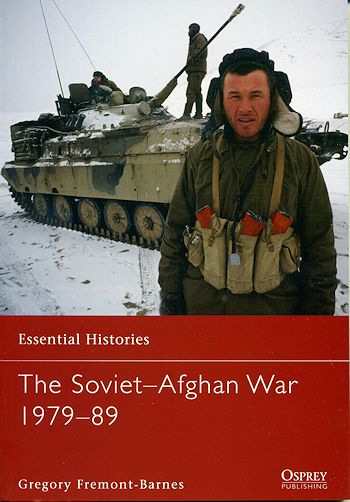Osprey's The Soviet-Afghan War
1979-1989
|
Author: |
Gregory Fremont-Barnes |
|
Publisher/Distributor |
Osprey Publishing |
|
Price |
$20.95 MSRP |
|
Reviewer: |
Scott Van Aken
|
|
Notes: |
96 pages, 7¼ x 9¼ inches, softcover
ISBN:978-1-84908-805-3 |
 There
is an old saying that often times, history repeats itself and never has that
been more true of the area in the world where Afghanistan is located. In many
ways, Afghanistan is a crossroads nation where trade routes converge carrying
goods to and from India and even into China on one side, the now Middle East on
to Africa and Europe on the other.
There
is an old saying that often times, history repeats itself and never has that
been more true of the area in the world where Afghanistan is located. In many
ways, Afghanistan is a crossroads nation where trade routes converge carrying
goods to and from India and even into China on one side, the now Middle East on
to Africa and Europe on the other.
This is an area where clan loyalties, religious
fanaticism, and corruption seem to be the overwhelming way of life. It is true
in many nations of the area that used to be called the Near East. They just
cannot be explained by European or American (neither North or South) standards.
It just does not work. World powers from the British to the US and the Soviets
have found this out to their chagrin, loss of life and waste of money.
It was during one of the major power struggles of the
1970s that the Soviets saw an opportunity to bring Afghanistan into the Soviet
sphere of influence. It was not their plan to conquer the nation, just to make
it Soviet friendly so that it would act as a buffer to other nations in the area
and help to spread the communist revolution.
Trouble was, other than a few corrupt politicians, the
people of Afghanistan just did not care. They had no interest in the glorious
revolution, did not want to be part of collective farming, did not care about
getting rid of hierarchy and very much did not want to change the way things
were. This was especially true of their religion, the way women were treated,
and the importance of their clan leaders.
The British learned this in their decades long war in
the late 1800s/early 1900s, the US is learning this today, and the Soviets
learned this in the 1980s during their decade long conflict. About all the
Soviets did was to make things worse and allow the Taliban to take control of
the country where they cruelly and harshly put their idea of religious rule into
practice.
The Soviets did quite a few things wrong but there were
two biggies. First of all, they did not understand how to suppress guerilla
fighters. They were trained for a standard, European conflict with a specific
front line where overwhelming firepower won the day. This did not work against
the Afghans as they did not play by the rules. They ran from overwhelming
firepower as they had nothing to use against it and instead used tactics any
American serviceman who has fought in Afghanistan will recognize. If the Soviets
came into a place and destroyed it, the Mujahedeen simply returned after they
left.
Secondly, they did not provide a large enough force to
be able to quell the Mujahedeen and put forces into place to hold territory. Add
to it that most Soviet soldiers were conscripts who did not have the fortitude
for the fight and did not want to be there and you can see why the Soviets
failed. Just like other Western powers who came into Afghanistan.
The author does a superb job of telling the story of the
Soviet-Afghan war. He covers how it was in Afghanistan before the Soviets became
interested, how the Soviets poured money and resources into trying to make
Afghanistan another communist country, how it failed, how the military was sent
in, what they dealt with and how they tried to change things. It seems very
familiar. They also failed.
It is a fascinating look into a culture few truly
understand and it shows what went wrong and why. An excellent read that anyone
with even a passing interest in the subject will want to read. Chock full of
photos and maps, it is highly recommended.
March 2010
For more on the complete line of Osprey books,
visit www.ospreypublishing.com. In the US, it is
Osprey Direct at 44-02 23rd St, Suite 219, Long Island City, NY 11101., where you can
get a catalogue of available books.
If you would like your product reviewed fairly and quickly, please
contact
me or see other details in the Note to
Contributors.
 There
is an old saying that often times, history repeats itself and never has that
been more true of the area in the world where Afghanistan is located. In many
ways, Afghanistan is a crossroads nation where trade routes converge carrying
goods to and from India and even into China on one side, the now Middle East on
to Africa and Europe on the other.
There
is an old saying that often times, history repeats itself and never has that
been more true of the area in the world where Afghanistan is located. In many
ways, Afghanistan is a crossroads nation where trade routes converge carrying
goods to and from India and even into China on one side, the now Middle East on
to Africa and Europe on the other.